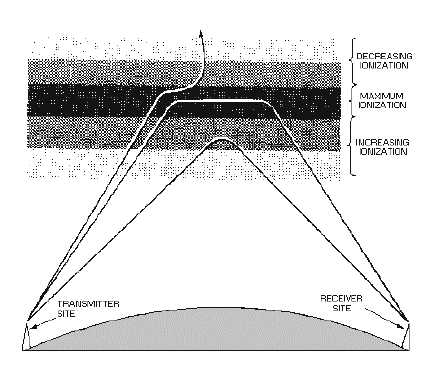2-21
Density of Layer
Figure 2-15 illustrates the relationship between radio waves and ionization density. Each ionized
layer has a central region of relatively dense ionization, which tapers off in intensity both above and
below the maximum region. As a radio wave enters a region of INCREASING ionization, the increase in
velocity of the upper part of the wave causes it to be bent back TOWARD the Earth. While the wave is in
the highly dense center portion of the layer, however, refraction occurs more slowly because the density
of ionization is almost uniform. As the wave enters into the upper part of the layer of DECREASING
ionization, the velocity of the upper part of the wave decreases, and the wave is bent AWAY from the
Earth.
Figure 2-15.—Effects of ionospheric density on radio waves.
If a wave strikes a thin, very highly ionized layer, the wave may be bent back so rapidly that it will
appear to have been reflected instead of refracted back to Earth. To reflect a radio wave, the highly
ionized layer must be approximately no thicker than one wavelength of the radio wave. Since the ionized
layers are often several miles thick, ionospheric reflection is more likely to occur at long wavelengths
(low frequencies).
Frequency
For any given time, each ionospheric layer has a maximum frequency at which radio waves can be
transmitted vertically and refracted back to Earth. This frequency is known as the CRITICAL
FREQUENCY. It is a term that you will hear frequently in any discussion of radio wave propagation.
Radio waves transmitted at frequencies higher than the critical frequency of a given layer will pass
through the layer and be lost in space; but if these same waves enter an upper layer with a higher critical
frequency, they will be refracted back to Earth. Radio waves of frequencies lower than the critical
frequency will also be refracted back to Earth unless they are absorbed or have been refracted from a

